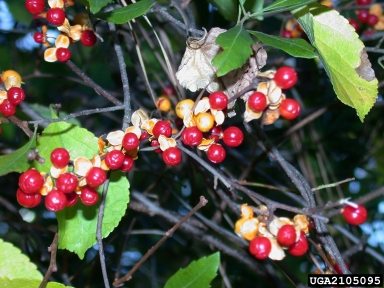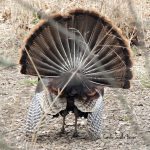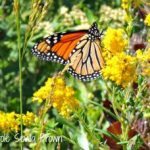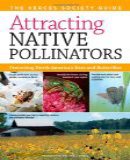Every week, we discuss one of the “Most Hated” plants, plants that are so invasive and damaging to ecosystems that they should never be planted, let alone sold. Many of these plants were introduced into this country as ornamentals by the horticultural industry and have since escaped the garden and are running rampant through native ecosystems and leaving a trail of destruction in their wake.
Our pick this week: Oriental Bittersweet (Celastrus orbiculatus), a particularly noxious invader, but also used in holiday decorations by influential folks such as Martha Stewart because of its pretty berries and ability to be shaped into wreaths. This was discussed on NPR over the weekend in Berry Bad: Threat to Trees Lurks on Holiday Tables.
The trouble with using bittersweet vine in holiday decorating comes from the berries, which each contain a seed just waiting for a patch of soil in which to germinate. When the holidays are over, the wreaths are often thrown onto compost piles or into the woods, where the seeds germinate and begin their destructive growth.
Oriental Bittersweet. native to China, Japan, and Korea, was introduced as an ornamental for the horticultural trade in 1860.
Ways Oriental Bittersweet damages ecosystems:
- vines grow rapidly, claiming all available sunlight, overtopping trees and shading out everything below
- Often referred to as the “kudzu of the north” Oriental Bittersweet has extended its range to be considered invasive from Ontario
- south to Louisiana and Georgia and west to Iowa.
- the vines strangle their host tree support, eventually killing it.
- Birds love the berries, so the seeds get spread far and wide in their poop
Because birds eat the berries, this plant is often recommended by nurseries and garden writers eager to cash in on the popularity of habitat gardening for birds.
You may have noticed that although there are many books available on the subject of creating bird gardens, I have not recommended them here. I will not recommend any book that chooses to advocate the planting of invasive species.
You must learn to recognize which plants are invasive. Do not allow the nursery trade or book publishers to dictate plants until you have done your own homework. At the very least, please check with your state native plant society for a list of appropriate plants, and check with your local Extension Office to see what species are invasive in your area.
There is a native Bittersweet, American Bittersweet (Celastrus scandens), but this relatively rare native plant has been found to hybridize with invasive Oriental Bittersweet, which will weaken the genetic strain of the DNA of the native plant.
More From Ecosystem Gardening:
Submit your review | |
If only what you say were true about bittersweet! I planted four vines on my acreage over 30 years ago in an attempt to eventually be able to harvest some beautiful berries for decorating. Nope! One survives and there are so few berries produced that I've never been able to gather anything for my Martha Stewart Holiday table! It used to flourish in the ditches here in rural Iowa. I wish I could just throw some spent vines and berries on my compost pile and reap the harvest you claim I should be able to expect!
Chinese bittersweet is just awful. It is extremely hard to control in the garden, so I can only imagine its behavior in the wild.
I sympathize with and share your goals of averting extinctions and restoring ecological functions. That said I have become quite opposed to the way we deal with invasive species. This is nature not a war, there is no place for a "most hated" list when talking about our fellow Earthlings. We need to let go of our anger and open our eyes to all the facts of the matter. Oriental Bittersweet is spreading because it is well adapted to the conditions we have created for it. It is great dealing with shade the edge of Woodlands. It's great at producing nest/den sites for wildlife. It is great at producing biomass/pulling carbon from the air. It's berries provide great late winter "hungry gap" food for wildlife. It is in the middle of creating a new species via hybridization with American Bittersweet. One hybrid species (humans) should not be hating on another species for being in the process of hybridizing. Speaking of which, celastrus is genus native to North America. We need to manage this extinction crisis we find ourselves in with love and cleverness, not with wars of extermination.








